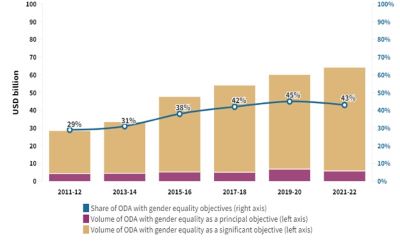Context
The urgent need to address climate change has become increasingly apparent in recent years, with the financing required for Sustainable Development Goals (SDGs) soaring from US$2.5 trillion to an astonishing US$4 trillion. In this landscape, mainstreaming gender into climate finance has emerged as a critical imperative. While discussions on climate finance have gained momentum over the past few decades, the integration of a gender perspective is a relatively recent development. Gender-smart climate finance seeks to embed gender considerations into financial investments, policies, and programs related to climate action. By recognizing the differential impacts of climate change on women and men, leveraging women’s unique skills and experiences, and promoting gender equality, this approach aims to empower women and enhance the effectiveness and sustainability of climate initiatives.
Understanding Gender Disparities in the Indo-Pacific
The Indo-Pacific region faces numerous challenges, including climate-induced disasters and growing gender disparities. Women in this region bear a disproportionate burden of unpaid care work, spending four times more hours than men, which impacts their employment opportunities. Gender disparities are further compounded by limited representation of women in decision-making roles within environmental ministries. Climate change exacerbates existing socio-economic inequalities for women and indigenous communities, particularly those reliant on natural resources for livelihoods. Natural disasters in the region disproportionately affect women, leading to higher mortality rates and increased vulnerability to gender-based violence.
Current Landscape of Gender Financing in Climate Action

Despite the pressing need to address gender disparities in climate action, only a minuscule fraction of global funding supports projects that simultaneously tackle climate change and women’s rights. Climate finance tends to be directed toward traditionally male-dominated sectors, with limited proactive efforts to address the gender gap. However, initiatives such as the Green Climate Fund (GCF) and the Sendai Framework have made strides in incorporating gender considerations into resource allocation decisions and disaster risk reduction strategies. Nevertheless, the allocation of climate-related Official Development Assistance (ODA) with gender objectives remains insufficient, raising concerns about the lack of focus on gender disparities in climate finance.
Efforts to Prioritize Gender Equality in Climate Projects
The Asian Development Bank (ADB) has prioritized gender equality and women's participation in climate projects across the Indo-Pacific, with a significant portion of Climate Investment Funds (CIF) projects integrating gender considerations. However, assessing the efficacy of these projects remains challenging due to their nascent implementation. Despite the allocation of adaptation finance earmarked for gender equality, there is a visible lack of prioritization of gender as a principal objective, particularly in comparison to mitigation efforts. Nevertheless, several actors in the region, including the United States, France, Japan, Australia, the United Kingdom, and India, have demonstrated commitments to mainstreaming gender considerations in climate action through various initiatives and partnerships.
Inclusivity and Quality Financing in the Indo-Pacific
In the Indo-Pacific region, an inclusive approach tailored to local contexts is crucial for addressing the intersectionality of gender and climate issues. While the region hosts a significant number of Clean Development Mechanism (CDM) projects, many vulnerable countries receive minimal funding, and small-scale initiatives benefiting women are often neglected. Closing gender gaps in the region could inject trillions of dollars into the economy, highlighting the strategic importance of integrating gender considerations into climate financing. Despite significant opportunities for deepening investment in gender-smart climate finance, challenges persist due to the lack of gender-disaggregated data and limited private sector involvement.
Conclusion
In conclusion, integrating a gender lens into climate finance is imperative for effectively addressing the challenges posed by climate change, particularly in the vulnerable Indo-Pacific region. While efforts to prioritize gender equality in climate projects have been made, there remains a substantial gap between the financing needed and the resources allocated. Moving forward, it is essential to adopt a gender-transformative approach and promote collaboration between state and non-state actors to unlock the full potential of climate finance. By doing so, we can build a more equitable and resilient future for all, aligned with the goals of sustainable development.
|
Probable Questions for UPSC Mains Exam
|
Source – Indian Express







